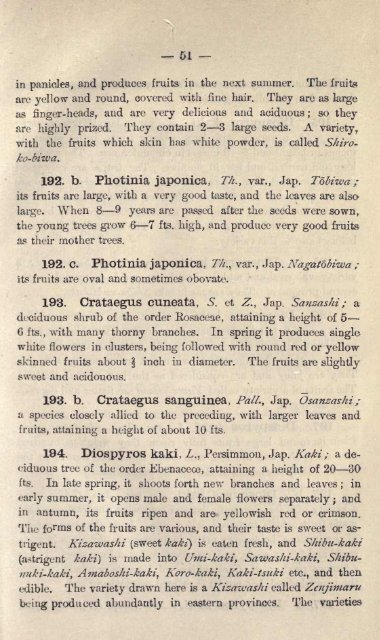Untitled - Library
Untitled - Library
Untitled - Library
Create successful ePaper yourself
Turn your PDF publications into a flip-book with our unique Google optimized e-Paper software.
51<br />
in panicles, and produces fruits in the next summer. The fruits<br />
ar.'<br />
yellow and round, covered with fine hair.<br />
They are as large<br />
as finger-heads, and are very delicious and aciduous ;<br />
so they<br />
are highly prized. They contain 2 3 large seeds. A variety r<br />
with the fruits which skin has white powder,<br />
is called Shiroko-biwa.<br />
192. b. Photinia japonica, T/i., var., Jap. Tobiwa /<br />
its fruits are large, with a very good taste, and the leaves are alsolarge.<br />
When 8 9 years are passed after the seeds were sown,<br />
the young trees grow 6 7 its. high, and produce very good fruitsas<br />
their mother trees.<br />
192. C. Photinia japonica, T/i., var., Jap. Nagaftbiwa ;<br />
its fruits are oval and sometimes obovate.<br />
193. CrataegUS CUneata, 5. et Z., Jap. Saiizashi ; a<br />
deciduous shrub of the order Kosaceae, attaining a height of 5<br />
6 fts., with many thorny branches. In spring it produces single<br />
white flowers<br />
in clusters, being followed with round red or yellow<br />
skinned fruits about \ inch in diameter. The fruits are slightly<br />
sweet and acidouous.<br />
193. b. Crataegus sanguinea, Pall., Jap. Osanzaski;<br />
u species closely allied to the preceding, with larger leaves and<br />
fruits, attaining a height of about 10 fts.<br />
194. Diospyros kaki, L., Persimmon, Jap. Kaki ; a de-<br />
of 20 30<br />
ciduous tree of the order Ebenaceoe, attaining a height<br />
fts. In late spring,<br />
it shoots forth new branches and leaves ;<br />
in<br />
early summer, it opens male and female flowers separately ;<br />
and<br />
in antumn, its fruits ripen and are yellowish red or crimson.<br />
The forms of the fruits are various, and their taste is sweet or asttigent.<br />
Kisawas/ii (sweet kaki)<br />
is eaten fresh, and Shibti-kaki<br />
(astrigent kaki} is made into Umi-kaki, Sawashi-kaki, S/iibu-<br />
)>uki-kaki, AmabosJii-kaki, Koro-kaki, Kaki-tsuki etc., and then<br />
dible. The variety drawn here is a Kisawashi called Zcnjimaru<br />
being produced abundantly in eastern provinces. The varieties
















